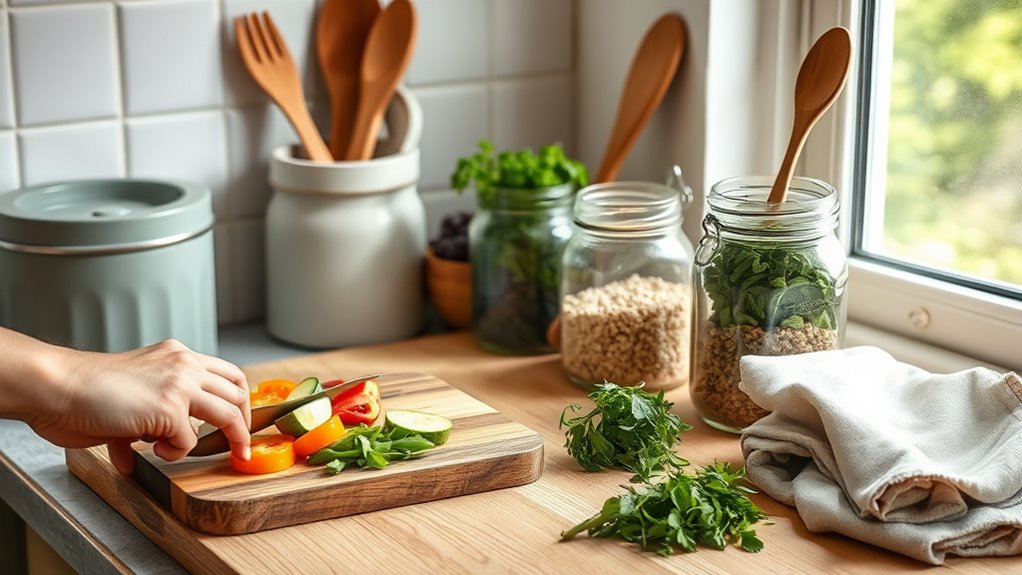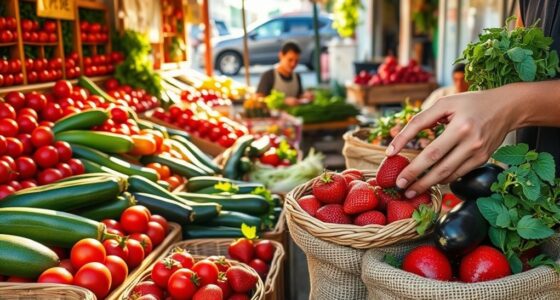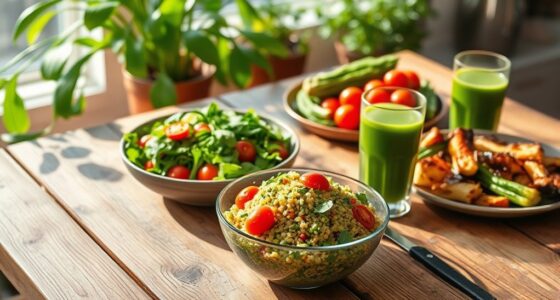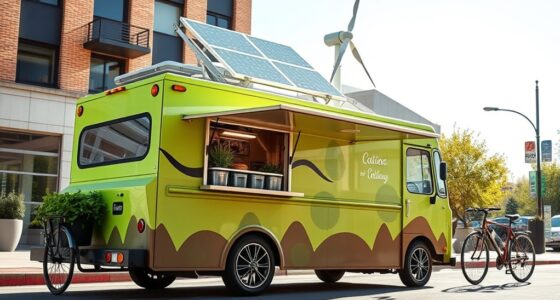Adopting zero-waste cooking methods helps you cut household waste, turn food scraps into valuable resources, and support eco-friendly habits. You can start by composting veggie peels, coffee grounds, and eggshells to enrich your garden soil. Creative reuse of food scraps, like making broth from vegetable stems or drying citrus peels, minimizes waste and saves money. Incorporating smart meal planning and mindful shopping reduces leftovers and packaging waste. To discover more practical tips and inspiring ideas, keep exploring how to fully embrace a zero-waste kitchen.
Key Takeaways
- Incorporate food scraps into composting or vermicomposting to return nutrients to the soil.
- Use vegetable stems, peels, and overripe fruits creatively in broths, smoothies, or baked goods.
- Plan meals to buy only needed items and prepare ingredients in portions to reduce leftovers.
- Repurpose day-old bread for croutons or other uses, minimizing waste.
- Cultivate a zero-waste mindset by adopting mindful shopping, cooking, and waste disposal habits.

Have you ever wondered how to cook delicious meals while minimizing waste? It’s a smart question, especially when you realize that a lot of your food scraps—peels, stems, cores, and ends—can be put to better use instead of ending up in the trash. Embracing zero-waste cooking means becoming more mindful of how you handle food, turning scraps into valuable resources through composting or creative reuse. When you start to see your food scraps as opportunities rather than waste, you’ll find yourself reducing your household’s overall waste footprint effortlessly.
Turning food scraps into resources helps reduce waste and makes cooking more sustainable.
Composting is one of the easiest and most effective ways to manage food scraps. Rather than throwing away vegetable peels, coffee grounds, eggshells, and fruit cores, you can add them to a compost bin. This process transforms organic waste into nutrient-rich soil, which you can use in your garden or houseplants. Not only does composting cut down on landfill waste, but it also closes the loop in your food cycle, giving back to the earth what you’ve taken from it. To get started, keep a simple container in your kitchen for collecting food scraps—preferably with a lid to contain odors—and empty it regularly into your outdoor compost pile or bin. If space is limited, consider vermicomposting with worms, which is an efficient way to compost indoors.
Beyond composting, you can also repurpose many food scraps into new meals. For instance, vegetable stems and leafy greens can be turned into flavorful broths or stocks, extracting maximum flavor and nutrients from every part of the produce. Instead of discarding onion skins or carrot tops, save them in a bag to simmer in water, creating homemade broth that’s free of additives. Citrus peels can be dried and used to infuse teas or baked goods, while overripe fruits make excellent smoothies or jams. By thinking creatively about your scraps, you reduce waste and stretch your ingredients further, saving money and minimizing your environmental impact.
Implementing zero-waste cooking methods also involves planning your meals carefully. When you shop, buy only what you need, and choose unpackaged or bulk options whenever possible to limit packaging waste. When preparing ingredients, be conscious of portions to avoid leftovers that might go bad. Use leftovers creatively—transform roasted vegetables into soups, or day-old bread into croutons. Every step, from shopping to cooking and storing, can become part of a zero-waste mindset. Over time, these habits will become second nature, making your kitchen more sustainable and your cooking more resourceful. Additionally, learning about food waste reduction strategies can help you optimize your efforts and make a larger environmental impact.
Incorporating composting and mindful use of food scraps into your routines isn’t just good for the planet; it also fosters a deeper connection with your food and your environment. As you embrace these methods, you’ll discover that zero-waste cooking isn’t about sacrificing convenience but about making smarter, more sustainable choices that benefit everyone.
Frequently Asked Questions
How Can I Start Transitioning to Zero-Waste Cooking Gradually?
To start shifting gradually, focus on simple steps like composting kitchen scraps and practicing bulk shopping strategies to reduce packaging waste. Begin by composting vegetable peels and coffee grounds, then gradually incorporate more composting techniques. When shopping, choose bulk items to minimize packaging. Small, consistent changes like these make zero-waste cooking easier and more sustainable over time, helping you build habits that markedly reduce waste.
What Are the Best Storage Solutions to Reduce Food Waste?
To reduce food waste, use reusable containers to store leftovers and fresh ingredients, keeping everything organized and easy to access. Consider composting options for vegetable scraps and food peels instead of tossing them away. This not only prevents waste but also enriches your soil. Keep track of expiration dates and plan meals to minimize spoilage. These simple storage solutions make your zero-waste cooking journey more effective and sustainable.
How Do I Handle Perishable Ingredients to Minimize Spoilage?
Imagine opening your fridge and finding perfectly preserved ingredients—it’s no coincidence. To handle perishable ingredients and minimize spoilage, you should use proper storage techniques, like airtight containers, and prioritize ingredient preservation by freezing or drying what you won’t use soon. Incorporate composting strategies for scraps to reduce waste further. This proactive approach helps extend freshness, prevents spoilage, and keeps your kitchen eco-friendly.
Are There Specific Tools or Equipment Recommended for Zero-Waste Cooking?
You should use reusable utensils and containers to cut down on waste, making your cooking more sustainable. Invest in quality composting bins to dispose of food scraps responsibly, turning waste into nutrient-rich compost. These tools help you minimize waste, reduce environmental impact, and support zero-waste cooking practices. By integrating reusable utensils and composting bins into your routine, you’ll make a positive difference for the planet while enjoying eco-friendly meals.
How Can I Repurpose Leftovers Effectively in My Meals?
Ever wonder how to turn leftovers into delicious new meals? You can repurpose leftovers by getting creative with meal planning—think stir-fries, soups, or salads. Use composting tips to dispose of vegetable scraps responsibly, reducing waste. Keep a container for leftover grains or cooked veggies in the fridge, ready for future dishes. This way, you minimize waste, save money, and enjoy varied, tasty meals every time.
Conclusion
By embracing zero-waste cooking, you become a steward of the Earth, transforming scraps into nourishing meals. Imagine your kitchen alive with the aroma of roasted vegetable peels and herb stems, each piece finding new purpose. As you chop, peel, and simmer with care, you create a symphony of sustainability. Every mindful choice paints a brighter future—where your table overflows with flavor and your efforts ripple out, nourishing both your family and the planet.








